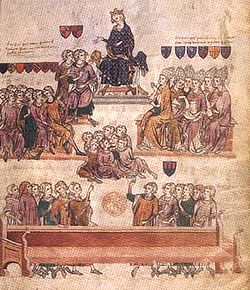Robert III (Artois)
Robert III von Artois (* 1287 ; † 1342 in London ), was from 1302 to 1309 a count of Artois and from 1310 to 1331 a count of Beaumont-le-Roger . He was a son of Philip of Artois (1269-1298), heir of Artois, and the Blanka of Bretagne (1270-1327). Through both parents he was a descendant of French kings from the Capetian dynasty , to whose side branch of Artois he belonged.
Life
When his grandfather, Count Robert II, died in 1302, Robert was still under the age of majority, which was exploited by his aunt Mathilde . She claimed that there was no legal evidence that his parents got married, so Robert was illegitimate and not entitled to inheritance. A long process followed, which Robert lost, with the final judgment of King Philip IV the Handsome appearing to have been heavily influenced by Countess Mathilde's Burgundian allies. For the loss of Artois, he was compensated with the county of Beaumont-le-Roger .
Robert is said to have been involved in the denunciation of the adultery of Margaret of Burgundy , first wife of the later King Louis X , in 1314 , whereupon the queen was arrested at Château-Gaillard and strangled there a little later (see: Tour de Nesle ).
Two years later he played an important role in the reintroduction of some noble privileges under Louis X. (1314-1316), which had been abolished by his father Philip IV (1285-1314). He achieved this together with Karl von Valois, among other things, through the deposition and execution of Enguerrands de Marigny , the king's advisor at the time, who under Philip IV had implemented important reforms in favor of the empire but to the detriment of the nobility.
In 1318 he married Johanna von Valois (1304-1363), daughter of Karl von Valois and sister of the future King Philip VI. Your children were:
- Katharina (* 1319; † 1368), ∞ Johann II. , Count of Aumale
- Ludwig (* 1320; † 1326/29)
- Johann Ohneland (* 1321; † 1387), Count of Eu
- Johanna (* 1323; † young)
- Jakob (* 1325; † after 1347)
- Robert (* 1326; † after 1347)
- Karl (* 1328; † 1385) Count of Longueville and Pézenas
Leaning process and exile
Because of his marriage, Robert played an essential role in the choice of his brother-in-law, Philip VI. became King of France in 1328 and was one of his chief advisers for a time. For his services he was awarded the dignity of a pair . Due to his close relationship with the new king, Robert believed he had a better chance of recovering Artois and in 1328 initiated a new feudal process before the court of peers. He succeeded in winning powerful advocates for himself with the Duke of Brittany and Count Charles II of Alençon . When Mathilde died in 1329 and King Philip VI. when Artois moved in for the time being, a decision in Robert's favor seemed to be in the offing. But then Mathilde's daughter and eventual heiress Johanna died in 1330 , whereupon her son-in-law, Duke Odo IV of Burgundy , claimed Artois for his wife Johanna . King Philip VI hoped to keep the Artois for the crown domain, and offered Robert and the Duke of Burgundy compensation payments, but the estates of the Artois refused to consent to the necessary tax levies. This made a decision for one of the two applicants inevitable. But when Robert tried to improve his position by means of forged documents, but this was discovered, the mood of the court changed against him.
Robert's goods were confiscated by the king in 1331, the court of peers awarded the Artois to the Duke of Burgundy and on April 8, 1332, declared Robert's banishment from France. He first turned to his nephew, Margrave John II of Namur , while his wife and sons went to prison. Philip VI called on the Bishop of Liège to attack Namur, whereupon Robert went on to Duke John III. fled from Brabant , his niece's husband. When Philip VI. Even Brabant threatened war, Robert fled to England in December 1336. There he encouraged King Edward III. to claim the French throne as a descendant of King Philip IV the Fair for himself, and thus contributed to the start of the Hundred Years War . He took part in Edward's campaign to Flanders in 1339 and was in command of the tied Battle of Saint-Omer in 1340.
Robert died of wounds he suffered in the 1341 war of the Breton Succession off Vannes . He was buried in St Paul's Cathedral in London .
He is one of the main characters in Maurice Druon's seven-volume novel "Les Rois Maudits".
Web links
| predecessor | Office | successor |
|---|---|---|
| Robert II |
Count of Artois 1302-1309 |
Mathilde |
| personal data | |
|---|---|
| SURNAME | Robert III |
| ALTERNATIVE NAMES | Robert III by Artois |
| BRIEF DESCRIPTION | Count of Artois (1302-1309); Count of Beaumont-le-Roger (1310-1331) |
| DATE OF BIRTH | 1287 |
| DATE OF DEATH | 1342 |
| Place of death | London |

